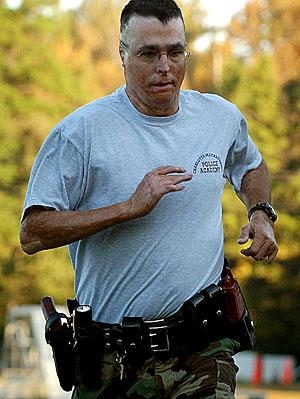 |
| from Charlotte Observer Online |
On March 23, 1994, a group of about 500 paratroopers gathered near a plane that would transport them to a site where they would take their jump. Michael Kelley stood with his companions and waited as the plane was filled with fuel. No one knew that this routine exersize was about to change their lives.
Just then, a cargo plane and a jet clipped each other in the air in the process of trying to land on the same runway. The cargo plane landed safely and the jet's passengers ejected, but the unmanned jet crashed into the transport plane, sending both into flames. A fireball, the size of a two-story building hurled toward the soldiers, many of whom had their back turned.
When Michael Kelley saw the rapidly approaching fireball, he dropped to the ground and rolled in accordance with his training. Unknowingly, he covered himself in fuel, and when the fireball passed over him, his clothes caught the flame. He tried to smother the flames by rolling more, but the fire only spread. Soon a rescuer came to his aid and doused the fire. By then, however, he was badly burned everywhere but his left shoulder and part of his left side. When the medics arrived, they sorted the soldiers into groups according to medical urgency and life status. They took one look at Kelley and placed him in the "expectant" group. This meant that the victims were to be made comfortable, because they were going to die.
Michael was the one person who overcame the label he was given, "doomed". Every person placed in the expectant group died following their rescue. Kelley was the exception. He went in and out of surgery, receiving skin grafts, amputation of burnt skin, and the fusion of his toe bones in an attempt to restore his original state. He spent two years in the hospital before he decided that enough was enough. He left the hospital with an ear and two fingers missing, barely able to move.
In 1997, Kelley retired from the army. He received a medical pension to support his family, yet Kelley felt it wasn't enough. He wanted to do something with his life, not glide through it. He knew he had to serve his country in some way. He found his chance with the Charlotte-Mecklenburg Police Department.
In March 2002, he looked into the requirements for a Charlotte police officer. He would have to take a physical pretest, and if he passed, complete weeks of training, then a grueling obstacle course. The pretest alone required 30 sit-ups, 30 push-ups, 40 reps on an aerobic step, and run a total of 400 yards. Michael Kelley had not run since the day of his accident. Still, he was determined to complete this.
Michael Kelley trained for six months before he was ready to take the pretest. He took it in December and passed with a minute to spare.On Monday, October 20th, after weeks of classes and training, he was ready for the obstacle course. This was the most trying test of all. The competitor must run long distances, drag heavy people from cars, crawl through concrete pipes, run up stairs, and force down a door, all in under 7 minutes and 20 seconds.
Though the bones in Kelley's foot were fused together, making running and jumping an incredibly difficult task, Michael Kelley completed the obstacle course in 6 minutes and 14 seconds. He went on to graduate, earn his badge, and become a member of the police force.
Page created on 6/30/2004 12:00:00 AM
Last edited 8/24/2018 1:00:28 PM
